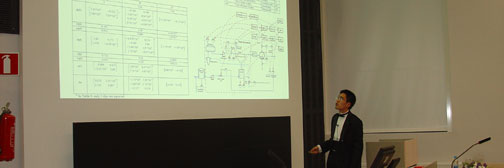| | Year 1998
Esa KatajainenMultivariable correlation analysis of a solvent extraction process
The aim of the thesis was to analyse the copper solvent extraction process. In the literature part of the thesis the state of automation in the solvent extraction and electrowinning processes were reviewed. This study also included a review of the fundamental principles of the SX-EW process and its chemistry. The basic controls of the four SX-EW process stages were presented. The Zaldívar SX-EW process was mathematically analysed in the experimental part in order to elucidate the behaviour of the poor electrolyte copper concentration.
The importance of the analysis lay in obtaining a predictive simple model with accuracy and reliability, the aim of which was to obtain sufficiently good results also in problematic situations. The results will form a basis for the design of future control applications. The explanatory variables were concentration data from an on-line analyser, two electrowinning current variables, and temperature and flow measurements from different stages in the process. The current variables will form the basis of the control applications.
The analysis of the Zaldívar SX-EW process was carried out using regression methods applied to an on-line database. Scatter plots between the selected explanatory variables and the poor electrolyte copper concentration supported the variable dependence type selections. Estimation error criteria of the absolute and percentual errors were used to select a combination of variables and their approximate lag times. Estimated models were checked using extra data points obtained from different time periods with the same criteria and fitting plots.
The experimental results were good. The copper concentrations of the rich electrolyte and electrolyte feed with the electrowinning currents satisfactorily explained the process behaviour. The constructed linear predictive model with ten explanatory variables gave small estimation errors. The electrolyte feed copper concentration was dominant in explaining the process. The electrowinning currents and the rich electrolyte copper concentrations also had an important effect on the poor electrolyte copper concentration. Acid concentrations, flows and temperatures had a statistical significant effect. The analysis revealed that the benefits attained from more complex non-linear models resulted in incorrect estimation values when extrapolating with extra data. The simple and rigid models worked in the changing process conditions. A five-variable model even improved the fitting, indicating slight changes in the process dynamics. The error plots suggested a possible outside temperature dependence. The results are applicable in the summer conditions of Zaldívar. There is no information available about the applicability of the study during winter conditions, and this should be investigated. The simplified, one-train modelling strategy give sufficiently good results owing to the identical properties of the trains and their control methods.
Deprecated: strlen(): Passing null to parameter #1 ($string) of type string is deprecated in C:\WWWroot\Root\incs\5_theses\theses_new2010.php on line 248
This info last modified 27 Apr 2024 - contact webmaster
|

